
The Phasmatodea are an order of insects whose members are variously known as stick insects, stick-bugs, walking sticks, or bug sticks. They are generally referred to as phasmatodeans, phasmids, or ghost insects. Phasmids in the family Phylliidae are called leaf insects, leaf-bugs, walking leaves, or bug leaves. The group's name is derived from the Ancient Greek φάσμα phasma, meaning an apparition or phantom, referring to their resemblance to vegetation while in fact being animals. Their natural camouflage makes them difficult for predators to detect; still, many species have one of several secondary lines of defence in the form of startle displays, spines or toxic secretions. Stick insects from the genera Phryganistria, Ctenomorpha, and Phobaeticus includes the world's longest insects.

Extatosoma tiaratum, commonly known as the spiny leaf insect, the giant prickly stick insect, Macleay's spectre, or the Australian walking stick, is a large species of Australian stick insect endemic to Australia. The species has the Phasmid Study Group number PSG9.
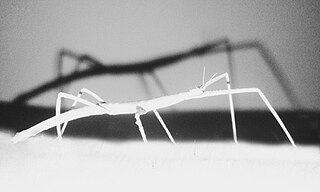
Carausius morosus is a species of Phasmatodea (phasmid) often kept as pets by schools and individuals. Culture stocks originate from a collection from Tamil Nadu, India. Like the majority of the Phasmatodea, C. morosus are nocturnal. Culture stocks are parthenogenetic females that can reproduce without mating. There are no reports of males, although in captivity, gynandromorphs are sometimes reared.
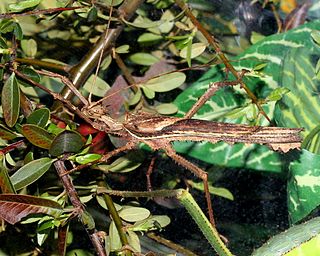
Heteropteryx dilatata is a large species stick insect, in the monotypic genus Heteropteryx and typical of the family Heteropterygidae. It is commonly kept in captivity and may be known as the: jungle nymph, Malaysian stick insect, Malaysian wood nymph, Malayan jungle nymph, or Malayan wood nymph. It originates in Malaya and is nocturnal. This insect holds the record for the largest egg laid by an insect. The eggs are about 1.3 cm (0.5 in) in length.

Megacrania batesii, commonly known as the peppermint stick insect, is an unusual species of stick insect found in northeastern Australia, the Bismarck Archipelago, the Solomon Islands, New Guinea, and possibly as far north as the Philippines. It is notable for its aposematic coloration, as well as its robust chemical defense mechanism. Its common name refers to the irritating fluid — with an odor resembling peppermint — that it sprays as a defensive action from a pair of glands located at its prothorax when threatened, as well as the cylindrical, twig-like shape of its body. A member of the subfamily Megacraniinae, it was first described by English naturalist and explorer Henry Walter Bates in 1865.
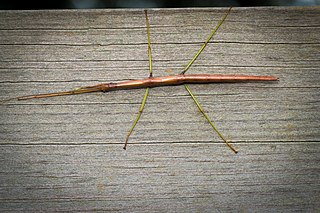
The common walkingstick or northern walkingstick is a species of phasmid or stick insect found across North America. The average length of this species is 75mm (3 in) for males and 95mm (3.7 in) for females.

Medauroidea extradentata, commonly known as the Vietnamese or Annam walking stick, is a species of the family Phasmatidae. They originate in Vietnam and are commonly found in tropical forests there. They eat a variety of foliage, though in captivity they commonly eat blackberry bramble, hawthorn, oak, red maple, and rose.

Acrophylla titan, the titan stick insect, is the second-longest stick insect found in Australia.

Tropidoderus childrenii, the Children's stick insect, was first described in 1833 by Gray.

Eurycnema goliath, the goliath stick insect, is one of the largest stick insects in Australia. The first instar of a nymph is small, brown, and ant-like, without wings, however the adult insects are green and yellow, though colors can slightly vary, are very large, and have wings.

Ctenomorphodes tessulatus, the tessellated stick insect, tessellated phasmid or tessulata stick insect, is a medium-sized, stick insect found in the Brisbane area of Australia. Fully grown males in mating season exhibit frenetic behaviour. This species is also parthenogenetic.
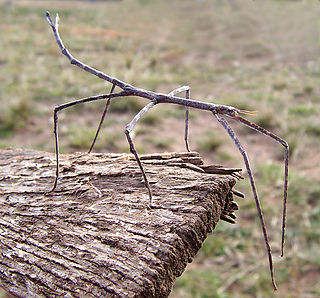
Ctenomorpha marginipennis, the margin-winged stick insect, is a species of stick insect endemic to southern Australia. The species was first described by George Robert Gray in 1833.

Achrioptera fallax is a stick insect species found in Madagascar.
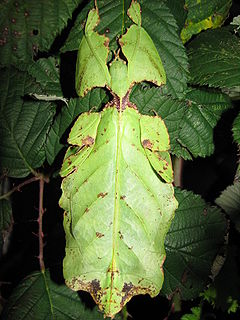
Phyllium giganteum, commonly known as the Giant Malaysian Leaf insect, is a species of leaf-insect described from Malaysia by Hausleithner in 1984 and placed in the genus Phyllium and family Phylliidae. Phyllium giganteum are the largest species belonging to the genus Phyllium reaching 105mm in size. They are found most abundantly in the west Malaysian tropics. The females typically have large elytra that lie edge to edge on the abdomen and tend to lack hind wings making them usually flightless. Males have small elytra and sometimes transparent non-leaflike functional hind wings. Phyllium giganteum found in the wild tend to be mostly females and the first male of this species was not found until 1994. The species has the ability to reproduce through parthenogenesis meaning the females are asexual. The primary reproductive pattern in the wild is unknown however in captivity, the females reproduce primary through parthenogenesis. Eggs tend to be brown or black and glossy and resemble the look of seeds. They hatch around 6 months after breeding. Newly hatched young nymphs tend to be wingless and brown or reddish in color. They develop their green color after feeding on leaves. Both the adult and larval stages are phytophagous meaning they feed on plants. The main plant food sources for this species are oak and bramble tree leaves.

Phyllium bioculatum, or Gray's leaf insect, is a leaf insect of the family Phylliidae native to tropical Asia as well as Madagascar, Mauritius and the Seychelles. It was first described by George Robert Gray in 1832, which was his first phasmid he discovered. Leaf insects have extremely flattened, irregularly shaped bodies, wings, and legs. They are usually about 5–10 cm long. They are called leaf insects because their large, leathery forewings have veins that look similar to the veins on the particular type of leaves they inhabit. Its scientific name bioculatum means "two-eyed" and refers to the two dots located on the abdomen just in this species.

Dryococelus australis, commonly known as the Lord Howe Island stick insect or tree lobster, is a species of stick insect that lives on the Lord Howe Island Group. It is the only member of the monotypic genus Dryococelus and was thought to be extinct by 1920, only to be rediscovered in 2001. It is extirpated in its largest former habitat, Lord Howe Island, and has been called "the rarest insect in the world", as the rediscovered population consisted of 24 individuals living on the small islet of Ball's Pyramid.

Sceptrophasma hispidulum, commonly known as the Andaman Islands stick insect, is a species of the stick insect family. It originates from the Andaman Islands and is commonly found in tropical forests there. They eat a variety of foliage, though in captivity they commonly eat blackberry bramble, hawthorn, oak, rose, and lettuce. The species has the Phasmid Study Group number PSG183.

Eurycantha calcarata is a species of phasmid endemic to Australasia.

Eurycantha horrida, the thorny devil walking stick, is a species belonging to the stick insects and to the family Phasmatidae.



















